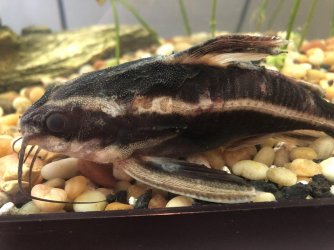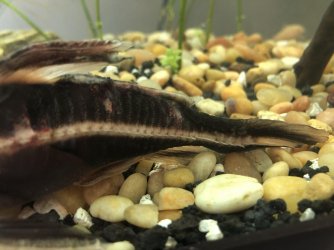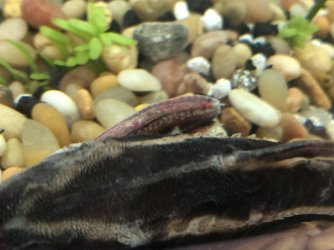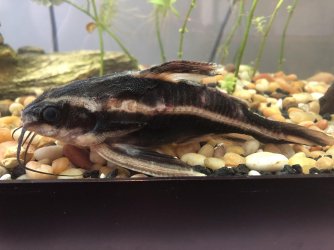cockwheat
New Member
Hi everyone! I am posting because I have run into a situation I cannot find a solid solution or explanation for. I have a 55 gallon tank with 1 Veiled Angelfish, 4 platy, 3 albino corydora catfish, a small population of Ramshead Snails, and 1 Raphael Striped Catfish. I do 35-40% water changes every 1-1.5 weeks depending on my workload for school that week. Before my situation now all of my readings were normal, pH is constantly at +/-7.5, ammonia and nitrites always 0ppm, and nitrates usually sitting at +/-20ppm. This past week I stupidly let a full two weeks go by between changes because I got busy with schoolwork, and I didn't really notice anything wrong until I changed the water, tested again, and saw my Raphael Catfish not looking too great. I did the first new water change 3 days ago and before I did the water change I noticed my Raphael was out of his 'hut' in the daytime, something super unusual for him. Upon closer inspection I saw small chunks of his skin seemingly falling off along with redness and apparent irritation on his dorsal fin and the joints of his pectoral fins, especially on the right one. He also has only returned to his hut once, seeming to prefer be sitting out in the open or lazily climbing the glass, two very odd behaviors for him. I thought this was weird not only because none of my other fish are showing any signs of sickness, but because catfish are supposed to be a bit more resilient than other types of fish when it comes to getting sick. Since the first water change I have been doing a 50% water change every day with a gravel vacuuming every other day. Starting yesterday I have started giving the Raphael a Methylene Blue dip according to the directions on the bottle along with a rise off in a bucket of aquarium water before being returned to the freshly cleaned tank. I am only using the Methylene Blue as a precaution because I truly cannot figure out what is wrong with him and I've seen many suggestions on various forms of other people recommending it for sick Catfish because they can be sensitive to a lot of other meds. Since yesterday he has only gotten visually worse, the right fin is extremely red with growing sores, it almost looks like it may be slightly swollen as well, and his eyes look like a cloudy film is growing over them. I am attaching pictures for reference. I am getting ready for today's water change right now and I've just tested the water, here are the parameters (These have essentially been the same since I've been doing the 50% changes every day):
pH: 7.5 (normal)
Ammonia: .5-.25ppm
Nitrite: 0ppm
Nitrate: 10ppm
Temp: 75F
I have a 20 gallon hospital tank I set up that is ready to go for him to be transferred into, I'm really just unsure of what my next steps should be for him! He is my baby and I'd do just about anything for him, there are two large specialty fish stores close to me so I'm willing to travel and get him what he needs! I appreciate any advice at all and thank you in advance!!
Edit: I forgot to add what treatments I use! I use API StressCoat and StressZyme every water change and have since the tank was started. Also there were no new additions to the tank!
pH: 7.5 (normal)
Ammonia: .5-.25ppm
Nitrite: 0ppm
Nitrate: 10ppm
Temp: 75F
I have a 20 gallon hospital tank I set up that is ready to go for him to be transferred into, I'm really just unsure of what my next steps should be for him! He is my baby and I'd do just about anything for him, there are two large specialty fish stores close to me so I'm willing to travel and get him what he needs! I appreciate any advice at all and thank you in advance!!
Edit: I forgot to add what treatments I use! I use API StressCoat and StressZyme every water change and have since the tank was started. Also there were no new additions to the tank!






